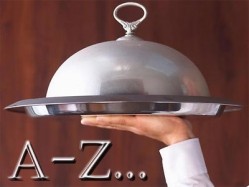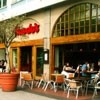The A-Z of Restaurants

A: Angel investor - An angel investor, or business angel, is a high net-worth individual who provides capital for a business start-up, usually in exchange for convertible debt or ownership equity. The current economic climate has made it harder than ever for restaurateurs to find the cash to start-up or grow their business, but as our recent Funding Hospitality Special Featureshows, an angel investor or other form of private funding could be the most effective alternative to high street banks.
B: Burger joints – One of the big ‘food trends’ towards the end of last year was the rise of the burger restaurant, particularly in London’s West End.Meatliquor, Patty & Bun, Tommi’s,Slider Bar and BRGR.CO– the list goes on. Last month, we reported on the big ‘burger controversy’as these burger businesses were warned by Westminster Council about the potentially fatal risks of selling rare and medium-rare burgers.
C: Casual dining – A casual dining restaurant is one which serves moderately-priced food in a casual atmosphere, bridging the gap in the market between fast-food outlets and the mid-market. They are often (but not always) part of a big chain, with examples here in the UK including Pizza Express, Frankie & Bennys and La Tasca. When it comes to getting more bums on seats than rival operators, many casual dining restaurants have become ‘locked into a discounting bind’ (see the next letter…)
D: Discounting – Discount vouchers have traditionally proved an effective tactic by operators in encouraging consumers to eat in their outlets and have risen in popularity since the recession. But the popularity of these schemes has raised concerns that some operators are now becoming reliant on them. With a few notable exceptions – including Côte, Jamie’s Italian and Nando’s – the major national restaurant chains are now falling back on deal sites, coupons and voucher codes to drive business when consumers’ purse strings are tighter than ever. Listen to our audio - Discount dining: Help or a hindrance for the restaurant sector?
E: EPoS – Electronic Point of Sales (EPoS) systems are self-contained, computerised pieces of equipment that help restaurant operators manage staffing, stock control and reservations, also ensuring a faster and more accurate level of service for diners. As Andrew Evans of EPoS solutions provider Keystep explains: “In the long term a good POS system can save you money, increase productivity and save you time that can be spent driving your business forward. No matter how small a business is, an EPoS system is rarely unnecessary as it will bring in business benefits.” EPoS will be a big part of our February Special Feature when we look at some of the latest technology available to the industry.
F: Fast-casual – A fast-casual restaurant is a type of restaurant that does not offer full table service, but promises a higher quality of food and atmosphere than a fast food outlet. In the UK, the fast-casual dining space is growing at pace, with established brands and emerging concepts filling the gap in the market between fast food and casual dining. Perhaps the best example of a growing fast-casual chain is the Portuguese chicken restaurant Nando’s, which was recently announced as Britain’s most popular dining concept.
G: Guides & awards – From Michelin stars through to the World’s 50 Best Restaurants Awards, being noted in a guide or awarded for good food quality and service can be a real differentiator for a restaurant, in some cases boosting the business’s popularity virtually overnight. As Michelin-starred chef Paul Ainsworth explained in this recent Career Profile interview:“The power of a Michelin star was bigger for me than appearing on the Great British Menu. The Twitter messages, the emails, the bookings – it just all went crazy immediately after the Guide’s release.”
H: High street - These are the streets that serve as a principal thoroughfare for traffic in a town or city. But, with restaurants, pubs and cafés now accounting for over a third of high street shops – could these high-footfall areas actually be losing their appeal for prospective operators? Christie & Co’s recent 2013 Business Outlookcertainly alludes to this, with the increasing number of business failures and scarcity of new opportunities forcing acquisitive restaurateurs to widen their search for new sites.
I: Immigration laws – A number of restaurant operators have been forced to scrap their UK expansion plans and shift their focus overseas because ‘punitive’ immigration legislation is preventing them from employing skilled chefs from abroad.Introduced in April last year, the rules have effectively closed the door on all but the most senior chefs hoping to join the UK restaurant industry. “The legislation makes it impossible for us to employ skilled people to actually cook the food,” says Namita Panjabi, who runs the Indian restaurant group Masala World with husband Ranjit Mathrani and sister Camellia Panjabi.
J: Josper Grill – Heston Blumenthal and Arjun Waney are two of the latest big-name restaurateurs to jump on the bandwagon for what has fast-become the chefs’ toy of choice, the Josper Grill. Blumenthal’s kitchen at the Mandarin Oriental in Knightsbridgenow has one, as does Waney’s recently opened Peruvian restaurant, Coya.But despite its recent rise in popularity, the Josper Grill has actually been around for over 40 years. It is often described as an oven but its primary role is as a grill, accommodating up to around 30 pieces of meat or fish simultaneously at a normal setting of 300°C. Would this fit into your dream kitchen? Maybe the next letter will give you some more ideas…
K: Kitchen equipment – A kitchen is at the heart of any business that wants to make food its main focus. So to be able to deliver the best to your customers, it needs to be working efficiently for you and your staff. In this four-part Special Feature,we looked at what you can do if your kitchen isn’t performing to its best abilities; presenting some of the best options for you depending on your budget. We looked at the pros and cons of a total refurbishment versus replacement of one or two key items. Plus, chefs told us about their favourite pieces of kit in an exclusive video and we rounded up the latest gadgets for the kitchen in our product gallery.
L: Like-for-like sales – These are the figures that help businesses and their investors determine the sales performance over a certain period of time when compared to the same period of time one year earlier; such as comparing the final quarter of 2012 with the final quarter of 2011. Like-for-like sales only take into consideration those activities that were in effect during both time periods, therefore excluding any effects of a restaurant groups expansion or acquisitions. As an example, the latest Coffer Peach Business Trackershows that the UK’s big restaurant groups saw an improvement in Christmas sales, with collective like-for-likes for the six weeks to 6 January up 2.1 per cent on the same period a year earlier.
M: Maître d’ - A Maître d’Hotel is the headwaiter of a restaurant and is responsible for ensuring the connection between kitchen and dining room runs smoothly. A well-trained Maître d’ is usually a foodservice professional who can also act as a sommelier, offer tableside finishing of food, keep waiting staff organised, and deal with customer complaints and issues.
N: No-shows – For restaurateurs, the problem of diners booking tables then failing to show with no warning is not a new one, but last year it seemed to reach a crescendo, particularly when Rene Redzepi of the World's Best Restaurant Noma told BigHospitality that his business had also been a victim of a 'no-show'.Our trail of stories on the subject provoked a flurry of responses from members of the industry who sympathised with those who'd spoken out and suggested potential workarounds such as taking deposits for bookings.Could the next letter actually be to blame?
O: Online booking portal – Booking websites such as Toptable are growing in popularity for restaurants, allowing them to potentially increase profits by seating more diners, taking more reservations and turning casual customers into regulars. But, like the letter D in this list, booking portals can be a double-edged sword for restaurants. When used successfully, they can do all of the above – but a number of high-end restaurateurs and industry experts have condemned the use of these online reservation systems, claiming that booking websites are in fact contributing to the growing number of people booking tables and not showing up.
P: Pop-ups - Granted, these are by no means a new phenomenon, but the increasing popularity of temporary ‘pop-up’ restaurants shows no sign of abating, with a huge number opening up last year (especially during the Olympics). They have been hailed as being particularly useful for younger chefs of late, allowing them to utilise underused kitchen facilities and experiment without the risk of bankruptcy. Whether it’s a 30ft-long shipping container, a rooftop Jubilee-themed ‘clambake’ or a steak and cocktail project occupying the upstairs of a pub, the pop-up restaurant has fast-become the new weapon in securing a permanent site. Want to know more? Read this.
Q: Quick-service restaurants – While fast food restaurants continue to remain a popular stalwart of modern dining culture, quick-service restaurants have become a key area of growth for the eating out market, with new ‘food-on-the-go’ conceptsconsistently emerging across the UK. “A wider variety of takeaway foods are available as consumers expect better quality food-on-the-go,” says Horizons’ director of services Paul Backman. “New quick-service specialists are emerging, such as outlets selling dishes with just one or two ingredients or Artisan versions of popular concepts. Many are focusing their attention on high traffic areas such as shopping malls, railway stations and airports.”
R: Reviews – With an increasing amount of review websites on the market and a continuing rise in the number of reservations being made online and through smartphones, it has become all the more important for businesses to be proactive when it comes to managing their online reputations through review websites such as TripAdvisor, Square Meal and Yelp. When managed successfully, reviews can turn you into an overnight success. But they can just as easily destroy your reputation,with negative comments able to spread like wildfire if left unchecked. “Review websites are all too powerful to ignore these days,” admits Magnus Hultberg, strategic advisor and former head of product management at online reservations system Livebookings. “There’s really no difference between a business’s reputation online or offline - and sites like TripAdvisor aren’t going away soon.”
S: Service – Following on nicely from the letter R, a recent report found that bad staff attitudes account for more complaints than the quality of the product you are serving. And, in such a competitive marketplace, an extra focus on service could be an effective way of standing out from the crowd for little or no extra cost. This extra focus on service has become even more apparent with this year’s launch of the inaugural Gold Service Scholarship,set up to inspire and reward the new generation of front-of-house staff. The final will take place on 11 February at Westminster Kingsway College.
T: Twitter – A couple of years ago we would have been writing about why it’s important to have a social media presence but, such is the fast-moving world of online, we can now presume that you’ve at least set up a Twitter account to promote your restaurant. So to the next step: are you aware of how your business is being perceived through Twitter and would you know exactly what to do if a customer decides to complain through Twitter rather than directly to you? Here’s our guide on how to manage your restaurant’s online reputation through social media.
U: Up-selling – A sales technique whereby a seller induces the customer to purchase more expensive items on the menu or other add-ons, in an attempt to make a more profitable sale. One good example of this, as highlighted by Michelin-starred chef Alan Murchison in this Pearls of Wisdom interview,is McDonalds. “Have you ever been to a McDonalds and not been offered an upsell? ‘Organic’, ‘free-range’, ‘healthy choices’ - They offer value and they upsell, and they train their staff to do so effectively. So as a business model, I’d say that’s probably far superior to most fine-dining restaurants here in the UK.”
V:Vegetables – Restaurant magazine recently predicted what the next year might hold for operators,with vegetables apparently set to loom large in 2013. This rise of the veg-centric menu will be partly a health thing (in response to the likes of the letter B in this list); partly also a reaction to the scarcity/unsustainability/cost of good meat; and partly chefs showing off their kitchen gardens. See Bruno Loubet in King’s Cross, L’Enclume/Roganic and Alexis Gauthier’s upcoming Vegetronic cookbook.
W: World’s 50 Best – The eyes of the world will once more fall on London this April as the World's 50 Best Restaurants Awards take place. Organised by Restaurant Magazine, the awards aim to get people talking about restaurants, and to shine a bright light on excellence and innovation in an exciting industry. Last year, Danish restaurant Noma was voted the World's Best Restaurant for the third year running,beating Spanish restaurants El Cellar de Can Roca and Mugaritz respectively to the top spot.
X: Xantham gum – For those of you who scrolled straight to X thinking BigHospitality wouldn’t be able to complete the full A-Z list – sorry to disappoint. Xantham gum is a popular ingredient found in a range of food products ranging from salad dressings and sauces to ice cream and gluten-free foods. It is an emulsifier made by fermenting corn sugar with a bacteria. It is also used as a thickener - in pastry fillings, for example, it prevents the water seeping out and soaking the dough, protecting the crispness of the crust. Now for Y and Z…
Y: Y-Generation
Self-centred and demanding with short attention spans - these are just some of the characteristics associated with ‘Generation Y’ – which relates broadly to the demographic of people born between 1975 and 1995. So what has this got to do with restaurants? According to the Taste of the Nation survey conducted last year by business advisory firm Deloitte, consumers from Generation Y are continuing to defy the recession as the leading demographic of consumers for eating out.Generation Y are also said to be reliant on new media and digital technology, which makes letters R and T all the more important.
Z: Zone 1 –
No roundup of the UK restaurant industry would be complete without a mention to the continuing vibrancy of London. Zone 1 of the capital remains the area with the highest spend in restaurants in the country, spending an average of £889 a year - £200 more than any other region. However, although central London still sees numerous openings every month, there is evidence to suggest that parts of the capital are struggling with the recession, just as much as the already-hit cities further north. Find out why here.




























